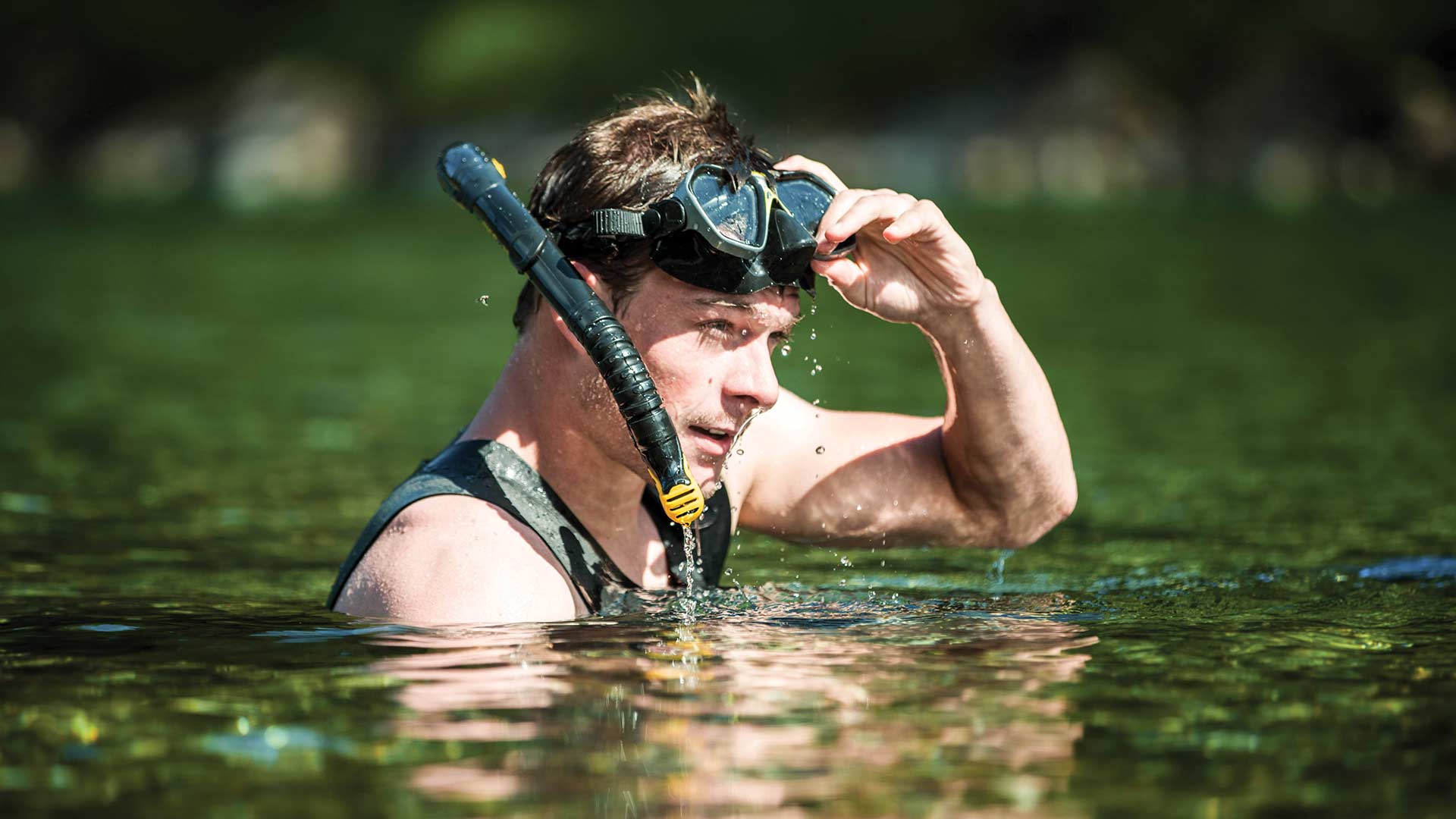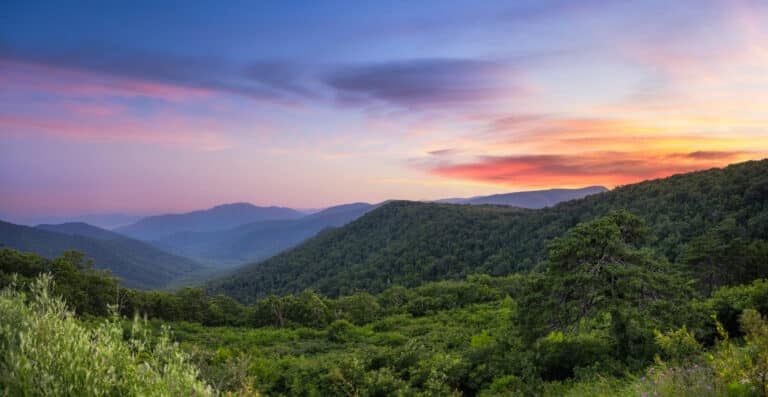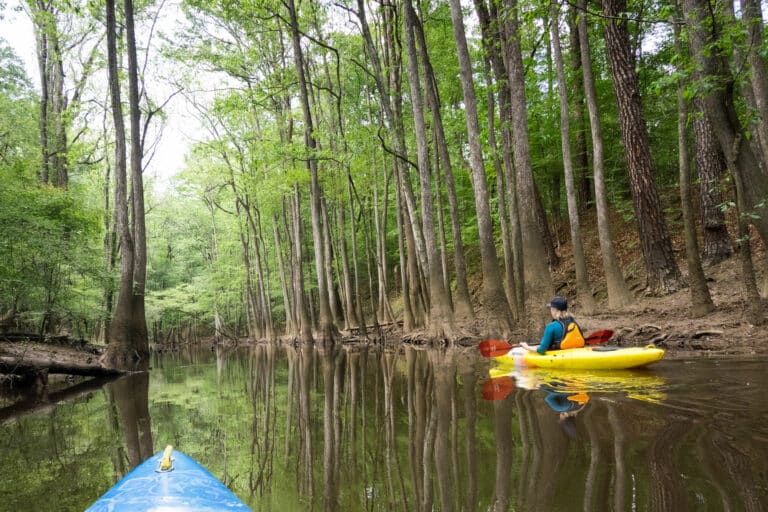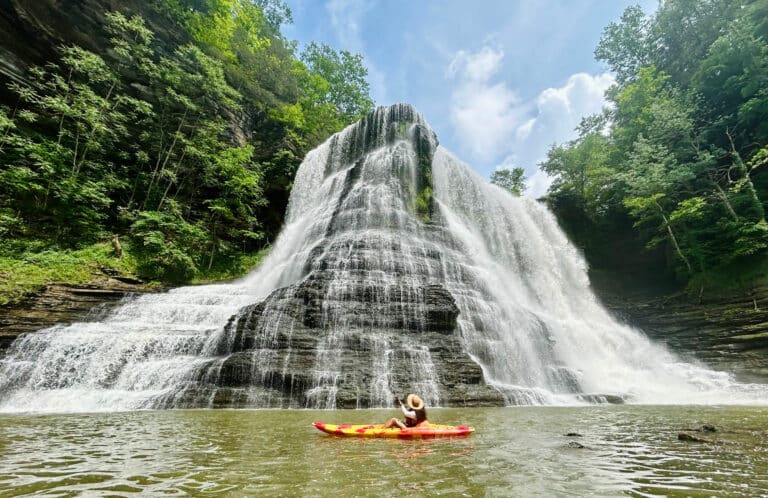Southern rivers are some of the world’s most biologically diverse. Snorkelers are taking the plunge to see for themselves.
Casper Cox sits neck-deep in the middle of the river, a purple snorkel strapped around his head. “We’re all attracted to beauty,” he says to the camera, pausing for effect, “and there is an enormous amount of beauty in this water.”
Cox is a featured player in a short video I’m showing to my college biology class, a group of 15 or so twenty-somethings from across the Southern Appalachians. Brook Trout hover just below the surface of a mountain stream. A hellbender salamander slinks by the camera in one shot, while a group of neon-orange shiners shimmers in another.
As the video plays, I sneak a look back at the class. We’re miles from the river, but the group of young adults might as well be in the water with Cox themselves. For maybe the first time the whole semester, not a single person is dozing off. Smartphones are placed face-down on every table. The students’ jaws are dropped.
For Jim Herrig, it’s a familiar reaction. “When you look at a river from above, you have absolutely no idea what’s in there,” says Herrig, a retired aquatic biologist with the Cherokee National Forest. The snorkeling trips featured in that video are in large part Herrig’s brainchild, an award-winning program blending outdoor recreation and science education that grew from Herrig’s career working underwater to inventory the southern mountains’ aquatic life. “You get in there that first time,” he says, “and you’re just amazed at what you’re seeing.”
In many ways, that aquatic biodiversity is the unsung star of Blue Ridge streams. The Appalachians, in fact, are home to some of the highest aquatic biodiversity in the temperate world. According to the University of Georgia’s River Basin Center, the Southeast is home to nearly two-thirds of the nation’s fish species and more than ninety percent of the United States’ freshwater mussels. That diversity peaks across the Tennessee River Basin, whose headwaters arc across the high elevations of the Blue Ridge from Virginia southward through North Carolina, Tennessee, and Georgia.
That wealth of wildlife often escapes public notice, but it’s part of a revival of sorts that’s working to raise the profile of Appalachian rivers. And that revival could not be coming at a more urgent time. Our regional rivers have taken a beating in recent decades, from high-profile coal ash spills on the Emory and Dan Rivers to a host of smaller incidents in streams all across the mountains. Unraveling what those events mean for our streams—and how the health of those waterways can best be rehabilitated—starts and ends with the often-unseen wildlife that lives within them.

Rebuilding a River
Nowhere is that importance more relevant than a short stretch of river near the town of Cedar Bluff, Va. Located not far from the tri-state junction where Virginia, Kentucky, and West Virginia meet, Cedar Bluff holds a place of infamy in the nation’s environmental history, thanks to what happened just outside town on August 27, 1998. Early that morning, a tanker truck carrying a chemical used in manufacturing rubber overturned on U.S. Highway 460, the main travel artery through town. Around 1,300 gallons of rubber accelerant spilled from the truck, making their way downhill into the nearby Clinch River.
Once there, the chemical turned the Clinch a milky white, wiping out aquatic life for miles downstream and killing an estimated 7,000 freshwater mussels. The effects of the spill were so intense that it is considered by many to be the single largest kill event in the history of the Endangered Species Act.
Two decades later, Tim Lane’s job is dedicated to restoring the Clinch River to its former glory. Lane, a mussel recovery coordinator with the Virginia Department of Game and Inland Fisheries, says that the mussel and fish diversity found in the broader Tennessee River basin make the watershed “our Amazon rainforest.” And it’s not just the value that those creatures have by simply existing that make them important, Lane says—their existence can benefit humans that depend on the river, too. “Some individual mussels can filter ten or 20 gallons of water a day,” he says. “This is a resource that’s cleaning our water for us.”
The work that Lane and colleagues are doing in the Clinch is a microcosm of what it takes to restore a degraded Appalachian stream, as well as how long that restoration process can take. A single spill event like the one in Cedar Bluff may last mere minutes, but its impacts can echo for generations. Recovery efforts for a 2008 spill of coal ash on Tennessee’s Emory River, for example, will require long-term monitoring for 30 years. Farther south, the Ocoee River watershed is still dealing with the impacts of copper mining that began in the 1800s at a spot upstream of the river’s 1996 Olympic whitewater course.
Water quality in the Clinch has improved somewhat in the two decades since the 1998 spill, but restoring the wildlife populations that once thrived there has needed help from biologists. Virginia Department of Game and Inland Fisheries’ s Aquatic Wildlife Conservation Center aids in that process by raising young mussels in the safe confines of captivity, releasing them back into the river once they are developed enough to survive on their own. The Center has raised 32 mussel species to date, including 14 federally endangered species that have been on the brink of extinction. But Lane says that the process of raising those mussels is half the battle.
“In mussel biology, we’re still in our infancy. We’re still learning about these species,” he says. One challenge lies in the fact that many freshwater mussels are reliant on a fish host to reproduce, meaning that immature mussels must attach to a particular fish species’ gills to complete their development into an adult. Figuring out where those fish hosts live—and where the right habitats for adult mussels exist in the river—can be key to successfully reintroducing the creatures into the wild.

River impoundments and impairments related to human land use can also put aquatic wildlife at risk. Understanding those hurdles and how they can best be addressed makes restoring a mountain stream all the more challenging.
Two-hundred miles south of the Clinch River, the snorkeling trips started by Jim Herrig and colleagues in Tennessee’s Cherokee National Forest are helping to raise awareness and support for river restoration. Herrig says that the program began in 2000 and tapped into a public curiosity about what lives in Appalachian streams. “I felt like we were really accomplishing something,” he says. “People came away just amazed at what they were seeing.”
Snorkeling trips began in the Conasauga River, a headwater tributary of the Coosa River that rises deep within Georgia’s Cohutta Wilderness. Since its inception, the snorkeling program has reached more than 6,000 people and has expanded into several other streams, including Tennessee’s Citico Creek and Hiwassee River. “We have streams here that you can step across which have six or more species in them,” Herrig says. “It’s just incredible diversity.”
In the past several years, that secret has gotten out regionwide. Conservation agencies, nonprofits, and outfitters all across the Blue Ridge have started similar snorkeling programs, placing biodiversity at center stage in regional streams. Outdoor enthusiasts can now dip their heads below water with experts from the French Broad River headwaters to Whitetop Laurel Creek along the Appalachian Trail in Damascus, Va. Virginia State Parks has even started its own “canorkeling” program—a mash-up between canoeing and snorkeling—along the Clinch River.
Snorkeling alone won’t save a river, but the experience it provides is a key cog in the network of partnerships that can. Lane says reviving rivers requires increased public support for the wild creatures inhabiting them.
Herrig hopes that snorkeling will become a larger part of the recreational landscape across the Blue Ridge, since the experience it provides is so different than what users see above the surface. To support that point, he brings up another montage of images that characterize Southeastern rivers: a child floats on an inner tube above an underwater salamander, while a fisherman wades along the river bottom—none of them fully aware of what lies beneath. It’s a metaphor, sure, but it also speaks an old truth about water quality issues: saving a river often means diving in headfirst.








